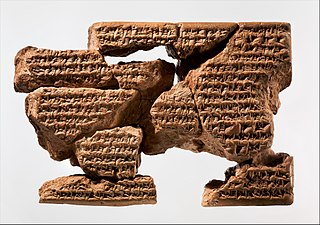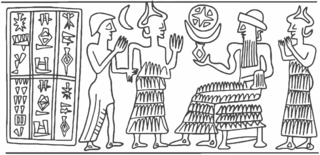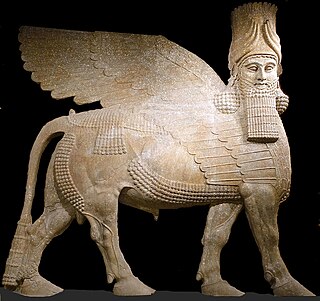Related Research Articles

Assyria was a major ancient Mesopotamian civilization which existed as a city-state from the 21st century BC to the 14th century BC, then to a territorial state, and eventually an empire from the 14th century BC to the 7th century BC.

Sîn-šar-iškun was the penultimate king of Assyria, reigning from the death of his brother and predecessor Aššur-etil-ilāni in 627 BC to his own death at the Fall of Nineveh in 612 BC.

Sargon I was the king during the Old Assyrian period from c. 1920 BC to 1881 BC. On the Assyrian King List, Sargon appears as the son and successor of Ikunum, and the father and predecessor of Puzur-Ashur II.

Erishum I or Erišu(m) Ic. 1974–1935 BCE, son of Ilu-shuma, was the thirty-third ruler of Assyria to appear on the Assyrian King List. He reigned for forty years. One of two copies of the Assyrian King List which include him gives his reign length as only 30 years, but this contrasts with a complete list of his limmu, some 40, which are extant from tablets recovered at Karum Kanesh. He had titled himself both as, "Ashur is king, Erishum is vice-regent" and the, “Išši’ak Aššur”ki, at a time when Assur was controlled by an oligarchy of the patriarchs of the prominent families and subject to the “judgment of the city”, or dīn alim. According to Veenhof, Erishum I’s reign marks the period when the institution of the annually appointed limmu (eponym) was introduced. The Assyrian King List observes of his immediate predecessors, “in all six kings known from bricks, whose limmu have not been marked/found”.
Aššur-nārāri I, inscribed maš-šur-ERIM.GABA, "Aššur is my help," was an Old Assyrian king who ruled for 26 years during the mid-second millennium BC, c. 1547 to 1522 BC. He was the 60th king to be listed on the Assyrian Kinglist and expanded the titles adopted by Assyrian rulers to include muddiš, "restorer of," and bāni, "builder of," to the traditional epithets ensi, "governor," and iššiak, "vice-regent," of Aššur.
Puzur-Ashur II was king during the Old Assyrian period c. 1880 to 1873 BC. Puzur-Ashur II had been both the son and successor of Sargon I. Due to Sargon I's long reign, Puzur-Ashur II came to the throne at such a late age that one of his sons, named Ili-bani, was a witness in a contract eleven years before Puzur-Ashur II became ruler. Puzur-Ashur II was succeeded by his son Naram-Sin. The following is a list of the nine annually-elected "limmu" ("eponym") officials from the year of accession of Puzur-Ashur II, the "waklum" ("overseer"), in the limmu of Ashur-iddin to Puzur-Ashur II's death in the limmu of Inaya BC dates are based on a date of 1833 BC for the recorded solar eclipse in the limmu of Puzur-Ištar:
Erishum I or Erišum II, the son and successor of Naram-Sin, was the king of the city-state Assur from c. 1828/1818 BC to 1809 BC. Like his predecessors, he bore the titles “Išši’ak Aššur” and “ensí”. The length of Erishum II's reign is uncertain, however; based on various excavated "limmu" (eponym) lists, Naram-Sin's and Erishum II's reigns had a combined length of 64 years.

The history of the Assyrians encompasses nearly five millennia, covering the history of the ancient Mesopotamian civilization of Assyria, including its territory, culture and people, as well as the later history of the Assyrian people after the fall of the Neo-Assyrian Empire in 609 BC. For purposes of historiography, ancient Assyrian history is often divided by modern researchers, based on political events and gradual changes in language, into the Early Assyrian, Old Assyrian, Middle Assyrian, Neo-Assyrian and post-imperial periods., Sassanid era Asoristan from 240 AD until 637 AD and the post Islamic Conquest period until the present day.

Ashur, Ashshur, also spelled Ašur, Aššur was the national god of the Assyrians in ancient times until their gradual conversion to Christianity between the 1st and 5th centuries AD.
Kazalla or Kazallu (Ka-zal-luki) is the name given in Akkadian sources to a city in the ancient Near East whose locations is unknown. Its god is Numushda with his consort Namrat. There are indications that the god Lugal-awak also lived in Kazallu.
The Old Assyrian period was the second stage of Assyrian history, covering the history of the city of Assur from its rise as an independent city-state under Puzur-Ashur I c. 2025 BC to the foundation of a larger Assyrian territorial state after the accession of Ashur-uballit I c. 1363 BC, which marks the beginning of the succeeding Middle Assyrian period. The Old Assyrian period is marked by the earliest known evidence of the development of a distinct Assyrian culture, separate from that of southern Mesopotamia and was a geopolitically turbulent time when Assur several times fell under the control or suzerainty of foreign kingdoms and empires. The period is also marked with the emergence of a distinct Assyrian dialect of the Akkadian language, a native Assyrian calendar and Assur for a time becoming a prominent site for international trade.

Naram-Sin, or Narām-Sîn or –Suen, inscribed in cuneiform on contemporary seal impressions as dna-ra-am-dEN.ZU, had been the "waklum" or "Išši’ak Aššur" of the city-state Assur, listed as the 37th king of Assyria on the later Assyrian King Lists, where he is inscribed mna-ram-dEN.ZU, or a fragmentary list where he appears as -d30. He was named for the illustrious Naram-Sin of Akkad and took the divine determinative in his name Naram-Sin should not be confused with the Naram-Sin who had ruled Eshnunna for around twelve years It is probable that Naram-Sin of Assur was, however, contemporaneous with the earlier part of Ebiq-Adad II’s reign Naram-Sin of Assyria was the son and successor of the short-reigning Puzur-Ashur II, filiation preserved in his seal impression on the envelopes of the waklum-letters to his expat Anatolian-based traders at the karum Kanesh and in the later Assyrian King Lists.

Ishbi-Erra was the founder of the dynasty of Isin, reigning from c. 2017 — c. 1986 BC on the middle chronology or 1953 BC — c. 1920 BC on the short chronology. Ishbi-Erra was preceded by Ibbi-Sin of the third dynasty of Ur in ancient Lower Mesopotamia, and then succeeded by Šu-ilišu. According to the Weld-Blundell Prism, Išbi-erra reigned for 33 years and this is corroborated by the number of his extant year-names. While in many ways this dynasty emulated that of the preceding one, its language was Akkadian as the Sumerian language had become moribund in the latter stages of the third dynasty of Ur.
Asinum was possibly a king of Assyria during the 18th century BC, and a grandson of Shamshi-Adad I. He was overthrown by Puzur-Sin because he was of Amorite extraction; not included in the standard King List, but attested in Puzur-Sin's inscription. It is unclear whether Asinum was a personal name or a title.
Aššūr-dugul, inscribed maš-šur-du-gul, “Look to Aššur!”, was the king of Assyria probably during the 18th century BC, a period of confusion in Assyrian history. Reigning for six years, he was the 44th ruler to be listed on the Assyrian Kinglist, and was designated by the list as a usurper succeeding the dynasty founded by Shamshi-Adad I.
Puzur-Ashur I was an Assyrian king in the 21st and 20th centuries BC. He is generally regarded as the founder of Assyria as an independent city-state, c. 2025 BC.

The timeline of ancient Assyria can be broken down into three main eras: the Old Assyrian period, Middle Assyrian Empire, and Neo-Assyrian Empire. Modern scholars typically also recognize an Early period preceding the Old Assyrian period and a post-imperial period succeeding the Neo-Assyrian period.
Aminu was according to the Assyrian King List (AKL) the 26th Assyrian monarch, ruling in Assyria's early period. Aminu is listed within a section of the AKL as the last of the, "kings whose fathers are known." This section had been written in reverse order—beginning with Aminu and ending with Apiashal “altogether ten kings who are ancestors”—and has often been interpreted as the list of ancestors of the Amorite Šamši-Adad I who had conquered the city-state of Aššur. This interpretation thus disputes that Aminu ever ruled Assur or Assyria. The AKL also states that Aminu had been both the son and successor of Ila-kabkabu. Additionally, the AKL states that Aminu had been both the predecessor and father of Sulili.
The Early Assyrian period was the earliest stage of Assyrian history, preceding the Old Assyrian period and covering the history of the city of Assur, and its people and culture, prior to the foundation of Assyria as an independent city-state under Puzur-Ashur I c. 2025 BC. Very little material and textual evidence survives from this period. The earliest archaeological evidence at Assur dates to the Early Dynastic Period, c. 2600 BC, but the city may have been founded even earlier since the area had been inhabited for thousands of years prior and other nearby cities, such as Nineveh, are significantly older.
References
- ↑ Chavalas, Mark (1994). "Genealogical History as "Charter": A Study of Old Babylonian Period Historiography and the Old Testament". In Millard, A. R.; Hoffmeier, James K.; Baker, David W. (eds.). Faith, Tradition, and History: Old Testament Historiography in Its Near Eastern Context. Winona Lake: Eisenbrauns. p. 120. ISBN 0-931464-82-X.